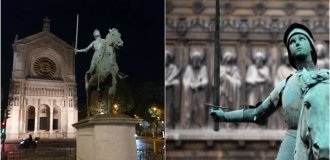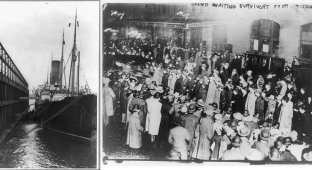The tragic fate of the Britannic. Mysteries of the death of the third twin of the Titanic (14 photos)
After D. Cameron’s film, which won 11 Oscars, “Titanic mania” began in the world. But not many people know that the legendary superliner had two twin brothers - the Olympic, launched about a year before the Titanic, and the Britannic, which left the stocks after its tragic death, but did not escape the same terrible fate.

Although the Britannic is not as romanticized or as capricious as the Titanic, its sinking remains one of the greatest maritime mysteries.
Following the Titanic.

Before the descent of the Britannic on February 26, 1914. Construction of the Britannic had already begun when news of the Titanic's sinking reached the Heartland. To avoid such a tragedy, the ship's creators made a number of changes to its drawings: the height of the watertight bulkheads was increased, the ship's double bottom was made thicker, and the space between the outer and inner bottoms was divided into compartments.

One of the waterproof partitions.

In addition, giant davits were built - winches for lowering boats, which were so lacking on the Titanic.

The Britannic was launched on 26 February 1914 at the Harland and Wolff shipyard in Belfast.

The company that owned the liner announced that the ship would begin service on the Southampton-New York route, the same route as the Titanic, in 1915. But due to World War I, the British Navy commandeered the Britannic and they made it a hospital ship.
Survive three disasters.

The hospital ship was crossing the Aegean Sea with 1,134 people on board.

Just after the end of morning mass on November 21, 1916, a young Irish maid, Violet Jessop, heard a dull roar. Let us add that by this time she had already survived the accident on the Olympic in 1911 and miraculously escaped in 1912 during the sinking of the Titanic. It was this woman who became the prototype for Rose, the heroine of D. Cameron's epic. “It was as if an inexplicable explosion had gone through the ship,” Jessop recalls, “it caused a continuous vibration along the entire length of the ship.”

The captain, trying to steer the ship into shallower waters, ordered the engines to work at full power and go full speed ahead. He did not know that the ship’s propellers, rotating at great speed, pulled the boats into the whirlpool and crushed the passengers.
Jessop jumped out of the boat to avoid the deadly propellers. And after some time I watched as another great ship went under the water. “The white pride of the oceanic medical world dipped its nose slightly, then sank deeper and deeper,” Jessop wrote in her memoir, Titanic Survivor, published in 1997.

Survivors of the sinking of the Britannic.
Soon after the tragedy, the British government put forward two official hypotheses: the ship was either torpedoed or was blown up by a German mine.
Riddles at the bottom.

In 1976, Jacques Cousteau discovered the exact location of the remains of the Britannic, 64 kilometers south of Athens. The ship (about 270 meters in length and with a displacement of 48,000 tons) lies on its side at a depth of 119 meters, almost intact. The fracture caused by the impact on the bottom is clearly visible.

Cousteau found the ship to be 6.75 nautical miles from the site declared by the British Admiralty in 1916, according to Simon Mills, a cameraman and amateur maritime historian who bought the wreck for $25,000 in 1996 from another collector of the remains. Mark Bamford's shipwreck, this discrepancy has given rise to several theories. It got to the point that some researchers even suggested that the British government itself sank the ship as a propaganda move to involve the United States in the war.
There are no unsinkable ships.

But other questions remain: why did the Britannic, whose safety was greatly enhanced after the Titanic tragedy, sank in 57 minutes? - three times faster than the Titanic?
The head of one of the five expeditions, Nick Hope, assured that he found no traces of German mine explosions. One of Hope's crew members entered the fire tunnel to ascertain whether the sealed hatches in the ship's bulkheads were battened down. He discovered that one hatch was open. “Another version,” says Hope, “the portholes near the waterline were open...”
Nick Hope said: “We spent 1,600 minutes around the wreckage. — record time for underwater observation, including photography and filming.” And it will help, Simon Mills hopes, to find the key to a mystery equal to that of the assassination of John F. Kennedy.

Robert Ballard, the marine explorer who found the wreck of the Titanic in the North Atlantic, also examined the site of the sinking of the Britannic in 1995. They discovered several holes in the ship's hull.
Ballard would like to turn the Britannic into a kind of underwater museum, with movie cameras on board that would transmit images to shore. Now many people are turning to him with a proposal to raise the Britannic. But Ballard's wish is to leave the ship where it is, as another shrouded in mystery reminder that no ship is unsinkable.























